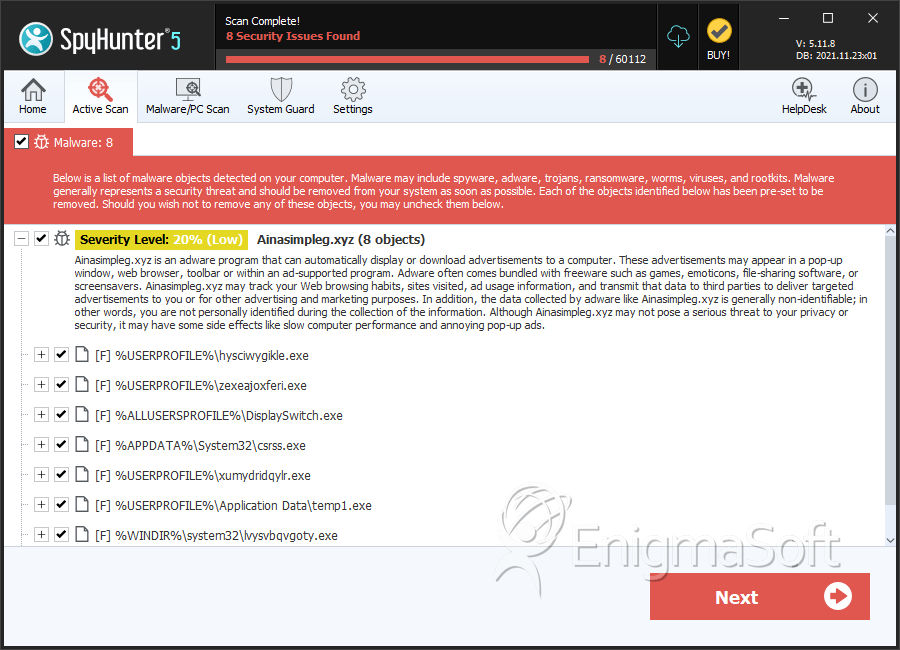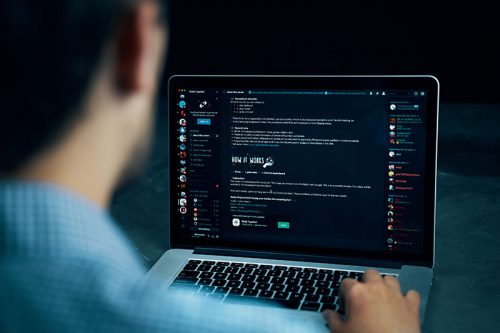Suspicious.cloud.5
Threat Scorecard
EnigmaSoft Threat Scorecard
EnigmaSoft Threat Scorecards are assessment reports for different malware threats which have been collected and analyzed by our research team. EnigmaSoft Threat Scorecards evaluate and rank threats using several metrics including real-world and potential risk factors, trends, frequency, prevalence, and persistence. EnigmaSoft Threat Scorecards are updated regularly based on our research data and metrics and are useful for a wide range of computer users, from end users seeking solutions to remove malware from their systems to security experts analyzing threats.
EnigmaSoft Threat Scorecards display a variety of useful information, including:
Ranking: The ranking of a particular threat in EnigmaSoft’s Threat Database.
Severity Level: The determined severity level of an object, represented numerically, based on our risk modeling process and research, as explained in our Threat Assessment Criteria.
Infected Computers: The number of confirmed and suspected cases of a particular threat detected on infected computers as reported by SpyHunter.
See also Threat Assessment Criteria.
| Ranking: | 17,866 |
| Threat Level: | 20 % (Normal) |
| Infected Computers: | 13,556 |
| First Seen: | January 19, 2012 |
| Last Seen: | June 29, 2024 |
| OS(es) Affected: | Windows |
If your anti-virus application is displaying the Suspicious.cloud.5 detection, this is often not cause to worry. Since September of 2010, PC security researchers have implemented new anti-virus technology that attempts to detect malicious software without it having to be in a virus database by going after characteristics of known malware threats. Suspicious.cloud.5 can often refer to the presence of a virus or Trojan on your computer system, but Suspicious.cloud.5 can also refer to software with alterations that may be entirely benign. ESG security researchers recommend taking any Suspicious.cloud.5 detection seriously and confirming the source of the detection in order to ensure that your computer system has not become infected with dangerous malware. The detection of a Suspicious.cloud.5 threat means that your anti-virus software has particularly sensitive anti-virus technology that detects suspicious files with characteristics that may point to previously unknown malware.
Table of Contents
The Suspicious.cloud.5 Detection Allows Security Researchers to Stay One Step Ahead
There is a constant arms race between cybercriminals and PC security researchers. Basically, cybercriminals release multiple versions of their malware while PC security researchers have to detect and confirm these in order to create virus databases that anti-malware software can use to help remove infections. However, detections such as the Suspicious.cloud.5 detection allow an anti-virus program to identify potentially dangerous software that may not contain a known virus signature. The Suspicious.cloud.5 detection will usually look for intentional changes made to malicious software, specifically malware that may have been creating by mutating previous malware programs.
What Does a Suspicious.cloud.5 Detection Mean?
Some antivirus programs are especially sensitive. If your anti-virus application is detecting a Suspicious.cloud.5 threat, this means that some files on your computer system are suspicious and may contain a malware attacker that was previously unknown. However, computer users need to understand that this kind technology is particularly sensitive and that it may also yield false positives, detecting applications with these same characteristics. ESG security researchers recommend identifying any files that were detected as Suspicious.cloud.5 threats manually and to submit them to your anti-virus manufacturer for confirmation if you suspect that the Suspicious.cloud.5 detection is accurate. When this happens, you may need to take measures to restore the detected file manually so that your applications' performance is not affected.
Aliases
15 security vendors flagged this file as malicious.
| Anti-Virus Software | Detection |
|---|---|
| AVG | BackDoor.Generic16.ABN |
| Fortinet | W32/Simda.C!tr |
| Ikarus | Backdoor.Win32.Simda |
| AntiVir | DR/Delphi.Gen8 |
| DrWeb | Trojan.Rodricter.21 |
| Kaspersky | Trojan.Win32.Inject.evjk |
| McAfee | Artemis!3E967233D5EF |
| AVG | Agent_r.BVC |
| Fortinet | W32/Foreign.CEBR!tr |
| Ikarus | Virus.Win32.Vundo |
| AntiVir | TR/FareitEP.A.10 |
| Kaspersky | Trojan-Ransom.Win32.Foreign.cebr |
| Avast | Win32:Fareit-EU [Trj] |
| McAfee | PWS-Zbot-FAXY!1A2D26A18DCD |
| AhnLab-V3 | Trojan/Win32.Agent |
SpyHunter Detects & Remove Suspicious.cloud.5

File System Details
| # | File Name | MD5 |
Detections
Detections: The number of confirmed and suspected cases of a particular threat detected on
infected computers as reported by SpyHunter.
|
|---|---|---|---|
| 1. | hysciwygikle.exe | d6d218c1a932495420c5371584594ba3 | 129 |
| 2. | zexeajoxferi.exe | ba8022bfcfabc73129c7c44538114f30 | 28 |
| 3. | DisplaySwitch.exe | 826d447909f470d211b6e47ecf317f59 | 20 |
| 4. | csrss.exe | 27abb62b3c469ae665f158bb16efec60 | 11 |
| 5. | xumydridqylr.exe | 45f0be3046082e97e098f2236a32ff37 | 11 |
| 6. | temp1.exe | 56b849924b6fb69079792b47583a5826 | 6 |
| 7. | lvysvbqvgoty.exe | ac8b37e9ef7f735d9e62449a4684b205 | 6 |
| 8. | KB3237683.exe | 79846904d8dc906ed0135a98d0f15ff6 | 6 |
| 9. | dxkaepsp.exe | e49e17d05aee81145b27fec6ec027ba0 | 5 |
| 10. | 1346043120.exe | 884affcf7757d26ee2846e168e59c645 | 4 |
| 11. | ciphtend.exe | cc109d875fd3c0603fda363a01e811e3 | 4 |
| 12. | sicasisyhifh.exe | 564ed9964355e7c1d07853546f40a338 | 4 |
| 13. | 02ef0990.exe | a64ac7e6312a9ec3861458004975ce2f | 2 |
| 14. | webyeryb3460vavaw.exe | 7c2417a93b410dfcde8d0bff76d00e10 | 2 |
| 15. | ofvjkphyr.exe | 44f92aa0c467bebf1afd472ebf3c6bc8 | 2 |
| 16. | 780b5df8fda898f39851917d8a235940.exe | 614a07eef02f4be374f676d001768583 | 2 |
| 17. | alg.exe | 90f0e823e72ef79d96bad92ca34264a4 | 2 |
| 18. | 4586202.exe | 1a2d26a18dcdf170010bc9ced7c94c5e | 2 |
| 19. | HP DVB-T TV Tuner.com | 1cbd466c4fd99b0f1c862edd0395820c | 2 |
| 20. | Q3w79.exe | 3e967233d5efc7019b6b591d07226b75 | 2 |
| 21. | 5375262.exe | 392307ba4e6e3ea73c7d5570d52e6eb7 | 1 |
| 22. | dxfkdiog.exe | 12451c0bb294dc455e0b49aad491c1c1 | 1 |
| 23. | wpbt0.dll | f09754f289d01c5f54e8e52894f5f410 | 1 |
| 24. | a7s7xh1sh5hj7-10038.exe | f1369fa388293b53dd6a456ce6366d46 | 1 |
| 25. | 1os0ieiryvktk-10083.exe | c64ee410c041ad74c5c39bb73fec43c2 | 1 |
| 26. | 6755868.exe | 65566caa7c85b30732bf85f0542ab377 | 1 |
| 27. | RANDOM CHARACTERS.exe |

Submit Comment
Please DO NOT use this comment system for support or billing questions. For SpyHunter technical support requests, please contact our technical support team directly by opening a customer support ticket via your SpyHunter. For billing issues, please refer to our "Billing Questions or Problems?" page. For general inquiries (complaints, legal, press, marketing, copyright), visit our "Inquiries and Feedback" page.